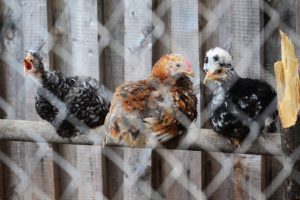Blue Laced Red Wyandotte chicks are quite an attractive and useful breed that has garnered adoration from poultry fanciers all over the globe. Famed for their impressive feather lacing and rich colour pattern, these chickens not only have style but also substance and are known for their excellent egg and meat yielding abilities. If you are already into raising chickens or if you are just planning to starting a Backyard Chicken project this complete guide will give you everything that you need to know to properly raise and take care of Blue Laced Red Wyandotte Chicks.
Key Takeaways
- Red Wyandottes are particularly categorized into the Blue Laced Red Wyandotte due to their extraordinarily distinctive feather lacing and rich color.
- The chickens are dual purpose hence they are good for both egg production and for meat purposes hence can be used as a addition to any many chicken projects.
- They are gentle famed, so they are ideal for families with kids and can interbreed with other chickens easily.
- To ensure that the chicks grow up healthy and strong, they should be offered a correct diet, proper housing and constant check up on their health status.
-
Knowledge concerning the background, the physical attributes of these cats, and the kind of behavior expected from them will enable one have a better way of managing the breed.
History and Origin of Blue Laced Red Wyandottes

The history of Blue Laced Red Wyandottes begins with their development in the 1870s. By crossing the Brahma chicken with several popular breeds, they obtained a new breed, the American Sebright. In 1883, the breed was renamed Wyandotte to honor a Native American tribe local to the breed’s roots in Northern New York and Southern Canada. The first color variation of Wyandotte chicken was a silver laced variety.
Physical Characteristics

Feather Lacing and Coloration
The Blue Laced Red Wyandotte is renowned for its distinctive color patterns. The feathers are primarily a rich red, beautifully edged with a striking blue lacing. This unique combination makes them stand out in any flock.
Body Shape and Size
These chickens are round and well-proportioned, sporting a classic Wyandotte figure. They have a broad, deep body and a short, well-bunged back, contributing to their round appearance. The average size for a Blue Laced Red Wyandotte hen tends to be around 6.5 lbs, while roosters can weigh up to 8.5 lbs. This makes them a medium-sized chicken, perfect for homesteads and backyard flocks.
Distinctive Features
One of the most notable features of the Blue Laced Red Wyandotte is their full, concealing tail feathers that pop out charmingly in flares. Additionally, they have bright red combs and pale-colored legs, adding to their overall appeal.
Temperament and Behavior
Some breeds are docile and friendly like the Blue Laced Red Wyandotte which will be befitting for a home rather than a commercialized one. They are usually docile and can also live in different statuses and habitats as there are still, cage-bound birds. They possess friendly temperament, which renders them suitable for homeowners with children as well as for enthusiasts.
The chickens are friendly with other breeds of chickens even though there might be some issue on who is the next in rankings for pecking. Their interactions must also be observed, particularly when transferring it to some new birds in the flock. All in all, one can denote that they are very easygoing birds that easily adjust to tracking in symbiosis with other similar birds.
Otherwise known as the Blue Wyandotte or the Bantam Blue Wyandotte, it is gentle and friendly and would be most suitable as a pet in a family home. They are easy to handle and can give a new look and new aspect to any yard or backyard; they are fun. This makes them good for families with children as they will not exhibit much aggression and will rather be affectionate with people around the children.
Egg Production and Quality

Laying Frequency
Blue Laced Red Wyandotte hens carry attributes that are not seen in other Wyandotte breed.impressive egg-laying capabilities.
Egg Size and Color
Factors Affecting Egg Production
Several factors can influence the egg production of Blue Laced Red Wyandottes:
- Diet: A balanced diet rich in nutrients is crucial for optimal egg production.
- Environment: Proper housing and a stress-free environment can significantly impact laying frequency.
- Health: Regular health check-ups and preventative measures help maintain high egg production levels.
Meat Production

Growth Rate
In terms of the rate of growth the Blue Laced Red Wyandottes are considered moderately growing birds, which makes them a good choice for people looking to have dual-purpose breeds. These chickens generally take between 16 – 20 weeks to achieve the desired market weight, which is relatively slower than specialized strains of broiler, but allows for the production of better quality lean meat within the required period.
Meat Quality
The actual meat you get from Blue Laced Red Wyandottes is tasty and tender free from the unpleasant smells we associate with typical chickens. Unlike most commercial breeds, their meat is not extremely juicy and offer them an authentic flavor. This makes them well suited for clients who aim for quality meat instead of quantity of poultry meat.
Ideal Butchering Age
It is important to note, that better results in meat yield and quality could be achieved if Blue Laced Red Wyandottes were dressed within the ages of 16 to 20 weeks. Slaughtering at this age helps in producing tender and tasty meat as well as the right muscular development for the birds since the time frame is ideal given their growth patterns The advised time frame is ideal for the most especially for those who have limited space for farming that is for the small scale farmers or even backyard We(ord)growers.
Care and Maintenance

Feeding Requirements
Just like all other chickens, Blue Laced Red Wyandottes need proper feeding whereby they are fed with both the commercial feed and the natural feeds in the right proportion. Gets fed on quality meals, particularly when they are still young and in process of growth. Make sure they get updated with clean water at their disposal all the time. Feeding them fruits, vegetables, fresh water and occasionally, meal worms or fresh greens are also options to consider.
Housing Needs
Living spaces refer to the environment in which the Blue Laced Red Wyandottes are kept, that is; housing plays an important role of your Blue Laced Red Wyandottes. A large enclosure that has proper flooring, adequate lighting and a properly designed area that prevents predators from accessing the poultry’s feed is a must. Another precaution is to ensure that the coop is cleaned always to avoid diseases affecting the chickens. For small-yard birds, such as laying hens, it is recommended that nesting boxes be made available.
Health and Wellness
Maintaining the health of your Blue Laced Red Wyandottes involves regular check-ups and vaccinations. Watch for signs of illness, such as lethargy or changes in behavior. Preventative measures like dust baths can help keep parasites at bay. Regularly inspect your flock for any health issues and consult a vet if needed.
Breeding Blue Laced Red Wyandottes

Breeding Blue Laced Red Wyandottes can be a rewarding endeavor, whether you’re aiming to enhance your flock or participate in poultry shows. Selecting the right breeding stock is crucial for maintaining the breed’s distinctive features and overall health. Look for birds with vibrant plumage, good body conformation, and a calm temperament.
Selecting Breeding Stock
In selection of breeding stock, it is recommended that, one selects birds that possess the breed standard of showing rounded birds which are generally quite plump and having full feathering. Another factor that farmers need to consider is choosing healthy birds which must be free from genetic defects, and which have good immune systems.
Incubation and Hatching
Taking into account that Blue Laced Red Wyandotte is coldclkolerated, incubation and hatching of the eggs should take place maintaining proper temperature and humidity levels. Some of the tips for personal grooming include ensuring that the body temperature is maintained at an average of 99 degrees at all times. 5°F and set the relative humidity of the incubator, depending on the size of the eggs, to 50-55% on the first 18 days, which should then be graded to 65-70 % in the last days to hatching. This helps in getting the maximum number of eggs hatching and the chicks that are hatched being in good health.
Raising Chicks
When they have young ones known as chicks, blue laced red Wyandotte require special care in warm and safe temperatures. Ensure the brooder has a heat source like heat lamp when rearing chicks and maintains 95 F for the initial week with reduction of 5 F in every subsequent week. Make sure they are provided with clean water and a good quality chick starter feed for this will give them the nutrition needed to grow to their optimal size.
Showing Blue Laced Red Wyandottes

Preparing for Shows
shows that require your Blue Laced Red Wyandottes need to be done to perfection, and thus, must be accompanied by a lot of attention to details. For this, be sure the feathers used are clean and groomed to bring out the distinct lacing and color of the particular bird. You should frequently look out for instances of parasites or diseases which may cause the dog to be dirty. One must also make sure that the animals are skilled enough to permit the trainers to place them in a cage and allow the animals themselves to be at ease in a cage during the show.
Judging Criteria
As for the judging of Blue Laced Red Wyandottes, there are some major points that are perceived as decisive. These are aspects such as the feather lacing, the depth of red coloration in their plumage, and their general body contours and build. Judges also focus on the unique characteristics in relation to other breeds, which are present in the particular breed in question. However, it should also be noted that certain breeds such as the Blue Laced Red are not strictly recognized by the APA meaning that they may have less credibility when entered in particular competitions.
Common Challenges
Some of the challenges that may come across by participants include; the management of the birds’ fether condition and making sure they do not stress. Traveling also causes stress to the chickens especially when transporting them to shows or events, therefore a suitable means of transport has to be found for the same. Moreover, it can turn to be highly competitive depending on keen interest that different players have shown in the same business. Competitive forces are always unpredictable thus having back and up plans.
Common Health Issues
Preventative Measures
Blue Laced Red Wyandottes do not have any breed related health issues commonly associated with this breed but like any other bird its health should be well monitored. Blinding should be prevented, and the use of anthelmintics should be periodic in order to avoid the build up of worm burdens although vaccinations can be useful when needed. People must also continue to take natural food products such as garlic cayenne and apple cider vinegar to boost their health.
Recognizing Symptoms
Any poultry diseases, including those monitor your Wyandottes require one to monitor his or her birds carefully. Self-sealing signs including incidences like exhaustion, refusal of feed, or the appearance of strange feces must be attended to. It is for this reason in the early stages of the diseases that the difference between life and death can be markedly influenced.
Treatment Options
Integrating into Existing Flocks

Introduction Process
Introducing Blue Laced Red Wyandotte chicks to an existing flock requires careful planning. Gradual integration is key to minimizing stress and aggression. Start by placing the new chicks in a separate but adjacent area where they can see and hear the older birds. This allows both groups to become familiar with each other without direct contact.
Managing Pecking Order
The different categories of chickens are as follows; Pecking order: This is natural order of chickens in the flock. This order can be interrupted when new birds are brought to their midst to make new members, which may lead to fights. To address this, it is recommended that the arrival of the new chicks be done at a time when the birds are relaxed and not significantly agitated, for instance during the evening period. It is also helpful to provide various feeding and watering points in an effort avoid turn-entailing competition and related aggression.
Monitoring for Issues
When designed together, it is important to observe the flock constantly to ensure that there is no bullying as well as possible health complications. Signs may include areas such as poor feeder management where the new chicks are isolated or even cases where new chicks are being pulled or attacked by their peers which is associated with a phenomenon known as feather pecking. This new introduction method should be used cautiously; if some complications occur then it is better to split birds and start the introduction process again but in a slower manner. A balance diet and/or routine health checks of the animals are important when it comes to achieving a healthy production of eggs.
Environmental Adaptability

Climate Tolerance
For many fanciers, Blue Laced Red Wyandottes are identified with some distinct characteristics that include remarkable adaptability to various climates. It can adapt to both hot and cold zones, which in a way, makes them ideal for many areas around the world. Still, pet owners need to satisfactorily house them in accordance with the species they are and their need for good ventilation in particular.
Free-Range vs. Confined
These chickens are contented moving around in circles as a result of their hard wired genetic programs that compel them to go around look for food in the compound, anything that makes these do so will make them be more physically active. As much as this is the case, they too can do well to remain in a small area providing that there is sufficient space for activities and adequate mental stimulation. This means that they will have to have time in the two variables where they are allowed to move freely in the flock and the run enclosure and this will make them healthy and always in high spirits fetching feed.
Seasonal Care Tips
Another factor that appears to be worse during the winter is that the birds must not be allowed to feel cold hence the need to ensure that the coop of your chickens is well insulated and light is not allowed to penetrate through any法人: In summer, people should make sure that there is enough of shady area as well as water for the animals to intake. Regularly assess patient’s signs and symptoms of heat stress or frostbite and alter their care as is necessary.
Conclusion
Frequently Asked Questions
What is the origin of Blue Laced Red Wyandotte chickens?
Blue Laced Red Wyandottes originated from the United States and were developed through meticulous breeding practices to enhance their unique coloration and physical characteristics.
How can I identify a Blue Laced Red Wyandotte?
You can identify a Blue Laced Red Wyandotte by its red feathers bordered by a smoky-blue lace edge, broad and deep body, and full, concealing tail feathers.
What is the temperament of Blue Laced Red Wyandotte chickens?
Blue Laced Red Wyandottes are known for their amiable personalities, making them suitable for families and easy to integrate with other chickens.
How often do Blue Laced Red Wyandottes lay eggs?
Blue Laced Red Wyandottes are excellent layers and regularly produce large brown eggs, making them a great choice for egg production.
What are the feeding requirements for Blue Laced Red Wyandottes?
Blue Laced Red Wyandottes require a balanced diet that includes high-quality poultry feed, fresh water, and occasional supplements to maintain their health and egg production.
Are Blue Laced Red Wyandottes suitable for showing?
Yes, Blue Laced Red Wyandottes are popular in the show ring due to their unique feather lacing and attractive appearance. They are often showcased for their vibrant plumage and well-rounded body shape.
What are common health issues in Blue Laced Red Wyandottes?
Common health issues include respiratory infections, parasites, and nutritional deficiencies. Regular health checks, proper feeding, and clean living conditions can help prevent these problems.
How do Blue Laced Red Wyandottes adapt to different climates?
Blue Laced Red Wyandottes are adaptable to various climates. They can be raised in both free-range and confined environments, with seasonal care adjustments to ensure their well-being.



